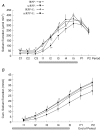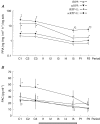Elevated renal perfusion pressure does not contribute to natriuresis induced by isotonic saline infusion in freely moving dogs
- PMID: 15254152
- PMCID: PMC1665168
- DOI: 10.1113/jphysiol.2004.066670
Elevated renal perfusion pressure does not contribute to natriuresis induced by isotonic saline infusion in freely moving dogs
Abstract
The study was designed to determine to what extent moderate elevation of renal perfusion pressure (RPP) via the mechanism of 'pressure natriuresis' contributes to the natriuresis induced by acute i.v. saline loading. Nine Beagle dogs maintained on ample sodium intake (5.5 mmol (kg body mass)(-1) day(-1)) were chronically equipped with an aortic occluder to servocontrol RPP, a bladder catheter to measure renal function, and catheters for measurement of RPP and mean arterial blood pressure (MABP). A swivel system allowed free movement in the kennel during experiments. Isotonic saline loading (500 ml in 100 min) was studied as follows: with and without servocontrol of RPP, and these two protocols repeated in the presence of angiotensin-converting enzyme inhibition (ACEI, Enalapril, 2 mg (kg body mass)(-1)). Saline loading increased MABP by about 12 mmHg and sodium excretion from about 28 micromol min(-1) up to about 350 micromol min(-1). Without ACEI, servocontrol of RPP at 10% below control 24 h MABP slightly delayed the onset of the saline-induced natriuresis, but did not reduce peak sodium excretion or cumulative sodium excretion. The slight delay most probably resulted from pressure-controlled renin release because, with ACEI, servocontrol of RPP did not delay or reduce the saline-induced natriuresis. In conclusion, pressure natriuresis does not contribute to the natriuresis following acute saline loading.
Figures




References
-
- Andersen JL, Andersen LJ, Sandgaard NC, Bie P. Volume expansion natriuresis during servo control of systemic blood pressure in conscious dogs. Am J Physiol Regul Integr Comp Physiol. 2000;278:R19–R27. - PubMed
-
- Atherton JC, Green R, Hughes S, McFall V, Sharples JA, Solomon LR, Wilson L. Lithium clearance in man: effects of dietary salt intake, acute changes in extracellular fluid volume, amiloride and frusemide. Clin Sci. 1987;73:645–651. - PubMed
-
- Bie P, Munksdorf M, Warberg J. Renal effects of overhydration during vasopressin infusion in conscious dogs. Am J Physiol. 1984;247:F103–F109. - PubMed
-
- Bie P, Sandgaard NC. Determinants of the natriuresis after acute, slow sodium loading in conscious dogs. Am J Physiol Regul Integr Comp Physiol. 2000;278:R1–R10. - PubMed
-
- Boemke W, Seeliger E, Rothermund L, Corea M, Pettker R, Mollenhauer G, Reinhardt HW. ACE inhibition prevents Na and water retention and MABP increase during reduction of renal perfusion pressure. Am J Physiol. 1995;269:R481–R489. - PubMed
Publication types
MeSH terms
Substances
LinkOut - more resources
Full Text Sources
Miscellaneous

